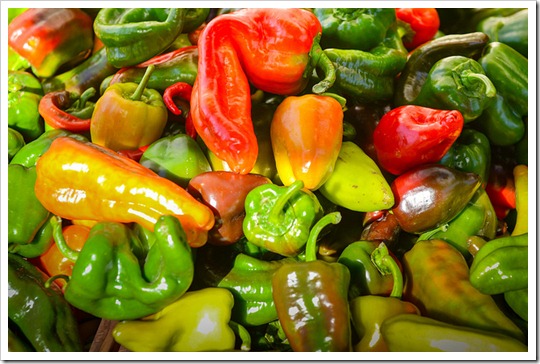La Peperonata Posted by Serena on Sep 4, 2014 in Uncategorized
It’s the end of summer, and the sweet capsicums are all ripening on the plants in the orto (vegetable garden): beautiful red and yellow fleshy peppers with their interesting contorted shapes. What can you do with so many peppers? you can grill or roast them, you can stuff them with breadcrumbs following this recipe, you can eat them raw in salads, or you can make a nice big peperonata. Here’s how:
 |
| … beautiful red and yellow fleshy peppers … Photo (CC) Franco Folini |
| Ingredienti: | Ingredients: |
| 1 kg di peperoni misti (rossi, gialli e verdi) | 1 kg of mixed sweet peppers (red, yellow and green) |
| 300 gr di cipolla, possibilmente rossa | 300 grams of onion, possibly red |
| 400 gr di pomodori pelati o di passata | 400 grams of peeled plum tomatoes or tomato passata |
| 6 cucchiai di olio extravergine d’oliva | 6 tablespoons of extra virgin olive oil |
| 2 spicchi d’aglio | 2 cloves of garlic |
| sale e pepe | salt and pepper |
| 1 ciuffo di basilico o di prezzemolo a piacere | 1 small bunch of basil or parsley as you prefer |
| 1 cucchiaino di zucchero, se necessario | 1 teaspoon of sugar, if necessary |
Preparation:
First prepare the vegetables: wash the peppers, cut them in half lengthwise, remove the top and the seeds, then slice into strips about 1 cm wide. Peel and slice the onions and the garlic. Put the olive oil in a wide casserole, preferably with a thick base which is more suitable for slow cooking (I like to use a terracotta casserole when I make peperonata and other vegetable stews). Add the sliced onion and garlic and leave to cook gently for about 10 minutes. When the onion is soft, add the peppers, mix them in, then cover with a lid and leave to stew on a low heat for about 20 minutes, stirring occasionally.
 |
| … with their interesting contorted shapes … Pepper No. 30 by Edward Weston, 1930 (image: Fair Use) |
In the meantime remove the seeds from the peeled plum tomatoes (if you’re using them instead of the passata), and blend or chop them into small pieces. When the peppers are almost cooked, add the tomatoes, salt and pepper, mix well, and leave to cook for another 15 minutes. About half way through taste the peperonata: if it’s too acidic add a teaspoon of sugar. When all the ingredients are well cooked, and the tomato sauce is thick, turn the heat off, and sprinkle the chopped basil or parsley on the top. Leave it to cool down, serve cold or tepid.
Variations:
La peperonata is very nice with the addition of a couple of potatoes cut into cubes along with the peppers. If you use potatoes you may need to add a bit of water to avoid the stew getting too dense.
You can also make this recipe using a 50/50 mixture of peppers and aubergines (eggplants) for another delicious variation.
The classic peperonata is made with tomato sauce, but I recently learned to make it without tomatoes, which is more digestible if you tend to suffer from acidity (I’m thinking of you Geoff!), and it still tastes very good. In this case you’ll need to add a little water half way through the cooking process.
Tip: la peperonata tastes much better when it’s made in advance, even a day or two before you intend to eat it.
Buon Appetito!

Build vocabulary, practice pronunciation, and more with Transparent Language Online. Available anytime, anywhere, on any device.




Comments:
William Auge:
Edward Weston, uno dei miei fotografi preferiti.
A.j. Drew:
I changed it up a bit by using twice the honey as sugar and a wee bit of vinegar I’d made with scorpion peppers. Love the heat. Excellent recipe. Thank you.
Serena:
@A.j. Drew Salve A.j. non c’è di che!
Saluti da Serena